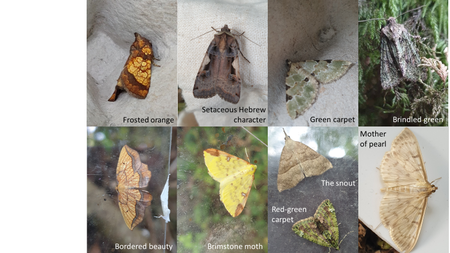Moths get a bad reputation as the dull brown insects that devour our winter jumpers. In fact, they are an extremely diverse and colourful group.There are approximately 2500 species of moths in the UK (only 5 of these will feed on our clothing!. They play key roles in our ecosystems, as pollinators for plants, and food for other insects, birds and bats.
I recently spent a few weeks conducting a mark-recapture study of moths in the lowland mixed oak and ash woodlands of South East England. These woodlands are extremely diverse and hugely important for UK insect biodiversity. Unfortunately, many are now very small and surrounded by intensive agriculture. Ash trees are common outside woodlands and may help insects travel between fragments. However, these trees are currently threatened by ash dieback, a fungal disease affecting ash trees across the UK. Therefore, my research aims to understand the impact of ash dieback on the movement of individuals between forest fragments and the consequences for species persistence at a local and regional scale.
Whilst on fieldwork I captured a diverse range of species. Most traps (pictured) contained dozens of ‘light emeralds’ and ‘large yellow underwings’, which, when alarmed flash their bright yellow underwing to startle potential predators. There were lots of beautiful autumnal colours ('frosted orange’, ‘bordered beauty’ and ‘centre-barred sallow’) and ornately patterned carpet moths. One of my favourite groups are the snout moths which are named after their snout-like mouth parts (they are adorable!).
Many moths do a good job of camouflaging with their surroundings to avoid predation. A ‘red-green carpet’ and a ‘brindled green’ are well camouflaged with the moss on trees; ‘willow beauty’ resembles tree bark, and ‘angle shades’ and ‘dusky thorn’ do a good impression of an autumn leaf. The ‘dusky thorn’ is likely to be impacted by the decline of its main food plant - ash trees!
The highlight of my field work was capturing the elusive ‘blue underwing’ (also known as a ‘Clifden nonpareil’ – meaning unrivalled or beyond compare). This magnificent moth is one of the UK’s largest, with a wingspan of up to 12cm. It went extinct in the UK in the 1960s but is thought to be breeding again in the South of England
It’s not just moths that visit the trap, they attract an array of beetles, shield bugs, crane flies, and vast numbers of European hornets. I really enjoyed learning about the incredible diversity and beauty of British moths. I would strongly encourage everyone to get outside and do the same. If you don’t have a moth trap, then all you need is a torch and a white sheet. I am already looking forward to next year’s fieldwork. This will involve a longer term-mark recapture study and the collection of some ash-associated species for landscape genetics to determine gene flow between fragmented woodlands on a large spatial scale



Great work and efforts from Fiona.Highly commendable.I suggest that you find scientific ways
of their multiplications and preservation from Predators.Moths are nocturnal animals that are harmless but have great benefits to the ecosystem and humanity.
Super images, thanks for sharing, moths are really beautiful and their camouflage is amazing. I had to look very hard to see the angle shades moth in your photo. And lucky you catching a blue underwing!
Amazing work Fiona! It would be great to know each details of how your work will pan out.